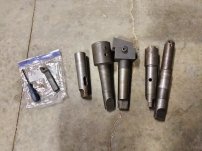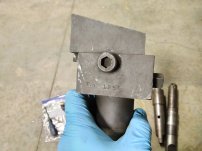Hi again hvnlymachining:
You can already improve things tremendously by just using one bushing at the outboard end.
It won't be great but it'll be better than it is now.
Even a mild steel spider welded up out of flat bar with a Delrin bushing knocked into it will help you a lot.
If you have some big diameter pipe kicking around you can make an end cap spider out of that...just cut cutouts around the periphery with a gas axe so the aligning cone and the chips can come out, put a cage to hold the bushing in the other end, line it up, tack it on, pull the cone, and go to town.
Of course, if you do that, you can't use universal joints...you have to rigidly tie the bar to the radial drill spindle.
It's more of a pain to align everything, but once you have it you can bore away.
Obviously you have to turn an accurate # 5 Morse taper on one end of the bar, and put in a cross hole and a setscrew hole for the cartridge
Make the outboard aligning cone shallow and tack it onto a mild steel flat bar , so you can pull it sideways out of the cutouts in the cap and so you can tack it in place with accessible tacks before you tack on the cap.
So you mount the bar in the fucked up bore with the two quick and dirty turned cones... the outboard one is tacked on the flat bar which is then tacked on the workpiece...the inner one can just be tacked directly to the edge of the hole so you don't have to build anything elaborate to hold the cones in place.
Mount the outboard cap, break the outboard cone tacks and pull the outboard cone.
Set up the drum on the radial drill with the bar still in place suspended between the outboard cap and the inboard cone.
Get everything lined up.
Knock off the inboard cone, connect the bar to the spindle and set the cartridge.
Bore away.
So some things to build, but they're simple things and you don't have to make them pretty...just functional.
Cheers
Marcus
www.implant-mechanix.com
www.vancouverwireedm.com









